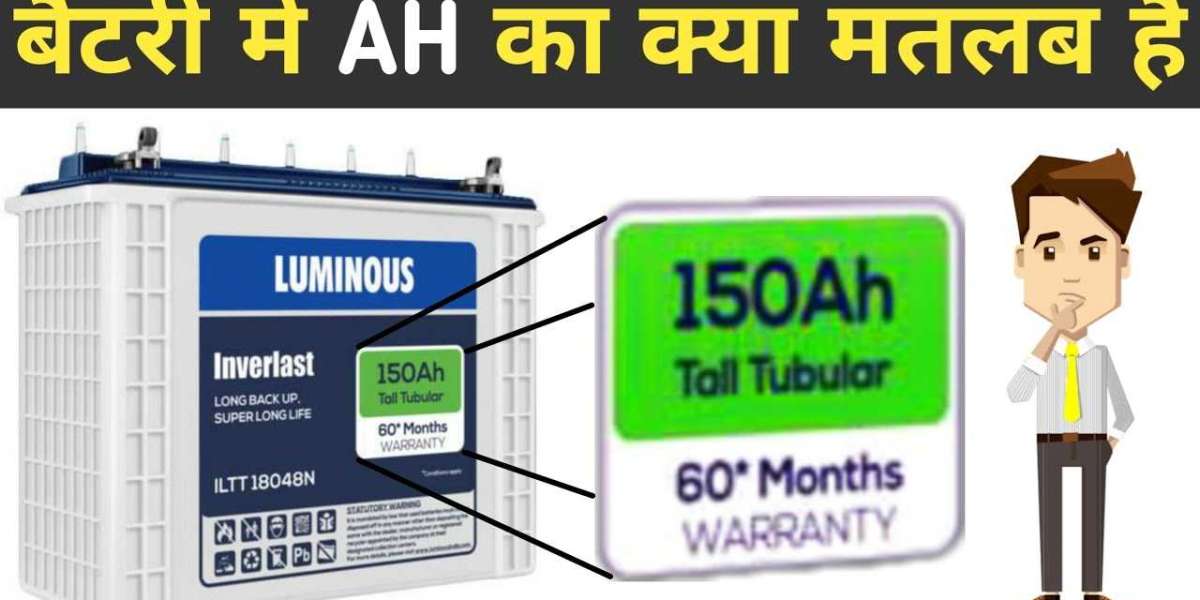When shopping for batteries, you may have noticed the term "Ah" displayed on the product label. Whether it's a car battery, RV battery, or portable power source, the Ah rating is a key indicator of battery performance. But what exactly does Ah mean, and how does it affect battery life and performance?
what does ah mean on a battery, we’ll dive into what Ah stands for, how it relates to battery performance, and why understanding this unit of measurement is essential for choosing the right battery for your needs.
What Does "Ah" Mean?
The term Ah stands for ampere-hour, which is a unit used to measure the capacity of a battery. More specifically, it indicates the amount of charge a battery can provide over a certain period—usually one hour. It helps you understand how long a battery can deliver power to a device before it needs to be recharged.
How Does Ah Work?
An ampere-hour rating tells you how much current (measured in amperes or amps) a battery can supply for a specific amount of time. For instance, a battery with a 10 Ah rating can deliver 10 amps of current for 1 hour. Or, it can provide 5 amps for 2 hours or 1 amp for 10 hours. Essentially, Ah is a way of quantifying how much energy is stored in the battery.
Formula Breakdown:
Ah=Amps×Time (in hours)\text{Ah} = \text{Amps} \times \text{Time (in hours)}Ah=Amps×Time (in hours)
So, if a battery can supply 2 amps for 5 hours, it would have an Ah rating of 10 (2 amps × 5 hours = 10 Ah).
Why Is Ah Important?
Understanding Ah is crucial when selecting a battery because it directly influences how long a battery will last in various applications. The Ah rating helps you gauge the battery’s capacity to power devices, from small electronics to larger systems like RVs and solar setups. Let’s break down why Ah matters:
1. Battery Life and Usage Time
The higher the Ah rating, the more energy a battery can store. For example, a 12V 100 Ah battery will last longer than a 12V 50 Ah battery, assuming both are powering the same device. This makes the Ah rating essential for determining how long a battery will power your device before needing a recharge.
For example:
- A 12V 50 Ah battery can power a device that draws 5 amps for 10 hours (50 Ah ÷ 5 amps = 10 hours).
- A 12V 100 Ah battery will power the same device for 20 hours (100 Ah ÷ 5 amps = 20 hours).
2. Choosing the Right Battery for Your Needs
Whether you’re powering your RV, solar system, or a small appliance, knowing the Ah rating helps you choose the appropriate battery capacity. For instance:
- If you need a battery for a small device like a flashlight, a battery with a low Ah rating (1 Ah or 5 Ah) may be sufficient.
- If you’re powering a larger system, like an RV or a solar storage setup, you’ll likely need a battery with a higher Ah rating (100 Ah or more).
Choosing the correct Ah rating ensures that your battery meets the demands of the devices you intend to use it with, without running out of power too quickly.
3. Battery Runtime Calculations
The Ah rating allows you to estimate how long your battery will last under a specific load. This calculation is useful for anyone relying on a battery to power equipment for a set duration.
To calculate how long a battery will last, use this formula:
Runtime (hours)=Battery AhCurrent Draw (Amps)\text{Runtime (hours)} = \frac{\text{Battery Ah}}{\text{Current Draw (Amps)}}Runtime (hours)=Current Draw (Amps)Battery Ah
For example:
- A 100 Ah battery running a device that draws 10 amps will last 10 hours (100 Ah ÷ 10 amps = 10 hours).
- A 50 Ah battery running a device that draws 2 amps will last 25 hours (50 Ah ÷ 2 amps = 25 hours).
Keep in mind, this is an ideal calculation, and real-world conditions (like temperature and battery age) may affect the runtime.
4. Battery Size and Cost
Larger capacity batteries (those with higher Ah ratings) typically cost more than smaller ones. However, selecting a battery that has the right Ah rating can save you money in the long run by reducing the need for frequent recharging or battery replacements. A battery with a higher Ah rating may be more expensive upfront but could provide a better return on investment, especially if you’re using it for an off-grid system or a vehicle.
Factors That Influence Battery Performance
While the Ah rating is a critical factor in determining battery life, other elements also play a role in how a battery performs in real-world conditions. These include:
1. Current Draw (Amps)
The amount of current a device draws directly impacts the battery’s runtime. Devices that require high amounts of power will drain the battery more quickly. For example, running a high-power appliance like a refrigerator will drain a battery faster than a low-power device like a lightbulb.
2. Battery Voltage
Battery voltage (e.g., 12V, 24V, 48V) affects how much energy a battery can supply. A higher voltage battery can power larger devices and systems. For instance, a 12V battery with a 50 Ah rating provides less energy than a 24V battery with the same 50 Ah rating.
3. Battery Type
Different battery chemistries offer various benefits in terms of capacity, efficiency, and lifespan. The two most common types are:
- Lead-acid batteries: These are often used in cars, RVs, and backup systems. They tend to have lower efficiency and shorter lifespans compared to other types.
- Lithium-ion batteries: These batteries are lightweight, have higher efficiency, and last much longer, but they can be more expensive.
Understanding the type of battery you need is just as important as understanding its Ah rating. Lithium-ion batteries, for example, offer better overall performance than lead-acid batteries, despite potentially having the same Ah rating.
4. Temperature
Extreme temperatures—whether too hot or too cold—can reduce a battery’s capacity and efficiency. It’s important to consider the operating temperature of the battery in your specific environment. For instance, batteries may perform worse in extremely cold conditions, reducing their usable Ah capacity.
5. Battery Age
Over time, batteries lose their ability to hold a full charge. This is especially true for older lead-acid batteries. A battery's Ah rating remains the same on the label, but as the battery ages, its real capacity decreases. You may need to replace an aging battery sooner than expected if its performance drops.
Common Applications of Batteries and Ah Ratings
1. RV Batteries
When choosing a battery for an RV, you'll often find Ah ratings between 100 Ah and 200 Ah, depending on the appliances and devices you need to power. A higher Ah rating is ideal for RVs that use more energy-intensive devices.
2. Solar Power Systems
Solar power systems often use deep cycle batteries, which are designed for frequent charging and discharging. These batteries typically have Ah ratings ranging from 100 Ah to 500 Ah or more, depending on the size of the system and how much energy you need to store.
3. Car Batteries
Car batteries typically range from 40 Ah to 75 Ah. These batteries provide enough power to start the engine and run the electrical systems of the vehicle.
4. Portable Power Banks
Portable power banks for charging devices like smartphones and laptops often have smaller Ah ratings, typically between 1 Ah and 20 Ah, depending on the battery's size and power capacity.
Conclusion
In summary, Ah (ampere-hour) is a key measurement that determines the capacity of a battery, and understanding it is essential when selecting the right battery for your needs. The Ah rating gives you insight into how much energy a battery can store and how long it can power your devices before requiring a recharge.
By considering the Ah rating alongside factors such as battery voltage, current draw, and the specific requirements of your application, you can choose the ideal battery to ensure reliable performance, optimal runtime, and the best long-term value for your investment.







